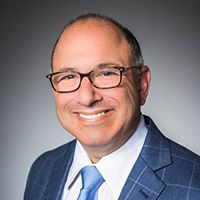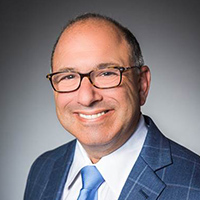Why Retirement Planning Must Start at the End (and Why Many Do It Backward)
If you feel dread when you think about retirement instead of gleeful anticipation, it could be because you don't know exactly what your goal is. Here's how to help target a savings amount and how to get there.

Stephen Covey, the author of The 7 Habits of Highly Effective People, advises readers to begin with the end in mind. After all, how can someone progress toward a goal if the goal is undefined? Unfortunately, that’s exactly how many people approach the biggest goal of their lives: retirement.
Some 70% of Americans feel they have inadequate retirement plans, according to a 2018 study by Northwestern Mutual. They don't know how much money they'll need, causing them to end up like the anxiety-plagued investor in one of TD Ameritrade's commercials. Though she saves on a regular basis, she has no idea if it's enough. She has recurring dreams of having to work at age 85 wearing a hot dog suit. Her fear is put to rest when her financial adviser assures her that creating a retirement plan based on her goals will prevent her from running out of money.
She was the victim of beginning without the end in mind.
From just $107.88 $24.99 for Kiplinger Personal Finance
Become a smarter, better informed investor. Subscribe from just $107.88 $24.99, plus get up to 4 Special Issues

Sign up for Kiplinger’s Free Newsletters
Profit and prosper with the best of expert advice on investing, taxes, retirement, personal finance and more - straight to your e-mail.
Profit and prosper with the best of expert advice - straight to your e-mail.
To avoid falling into the same trap when planning your own retirement, begin with the end in mind. Many people choose to plan backward to accommodate their lifestyle and situation. Start out by determining the annual income you will need during retirement. First, decide what you want out of life after you retire and what kind of price tag would be associated with it. Everyone has a different answer. Some people dream of traveling extensively, others are content enjoying time at home with loved ones. It's also important to consider the costs of hobbies and social activities, as well as maintaining a home and perhaps one day moving.
Warning: Expenses may go up during retirement
Most retirement planning assumes that expenses will go down during retirement. For those who plan to live a simple lifestyle without expensive vacations, this may be true for a while, but the risk of unexpected expenses doesn't end when you stop working. Living on a tight budget without emergency funds is as unrealistic in retirement as beforehand. A retirement plan should include a plan for coping with the unexpected.
Medical expenses, in particular, have the potential to drive up expenses beyond retirees' means. Medicare only covers so much. In addition to the cost of care, services like long-term care or in-home care may become necessary. Though most people don't like the thought of going into a nursing home, a retirement plan must include provisions for nursing home expenses.
Many solutions are available to cover these possible expenses, including Medicare supplemental insurance policies and nursing home insurance. A knowledgeable financial planner can determine the best solutions and include the cost in your overall retirement plan.
Scenario planning provides a method for determining needs and choosing the right amount of savings and insurance.
To calculate how much to save, multiply by 25
Many retirement planners take their client's projected annual spending in retirement and multiply it by 25 to create a savings goal. This method provides a realistic target based on spending rather than income. Projected Social Security payments, annuities or pensions are factored into the annual spending amount.
This calculation does not imply that the client will live 25 years or less in retirement. Rather, it calculates the amount of a portfolio required so that the retiree can take 4% distributions each year to cover their expenses. The remainder of the money remains invested and earns a return. A sustainable retirement plan generates enough return to cover distributions, providing the retiree with income for as long as he or she lives and an estate to leave for the children or other relatives.
An example of how it all works
Paula, a successful executive in her late 50s, had grown exhausted of her stressful career. Although she was making $200,000 a year, she wanted to pursue a job more fulfilling. Paula always loved children. Her dream was to work at an amusement park. She wanted to be surrounded by joyful people, and most importantly, she wanted a job that didn’t follow her after hours.
When I met Paula she had recently met with her financial adviser and asked him to put a plan together that would let her follow her dream. Her adviser told her it was impossible. That she would have to put off her dream or drastically change her life, which meant selling her house and cutting her living expenses in half. Paula was looking for a second opinion.
There was no way Paula would be able to leave her job if she was only making a small income along with 4% a year from investments. However, Paula’s husband would be receiving a significant pension in 10 years in addition to his retirement savings. While Paula might have to use some of her retirement money now, her husband’s pension would more than make up for the reduced income from her retirement savings.
Paula’s new plan incorporated her husband’s pension, some income from annuities and a traditional investment portfolio. Using this approach, she was able to turn her vision into a reality. Currently, Paula and her husband are retired and are off traveling the world.
Planning for retirement and generating enough retirement income is more challenging today than it has ever been. Low interest rates combined with market volatility and political uncertainty requires planners today to think much more broadly. Many financial planners today are stuck with one approach, one method of growing assets and generating income. There is the market only crowd and the insurance only crowd. To achieve real security in retirement it takes using all options, all investments that are appropriate for your situation.
How to help reach your savings goal
Creating a sustainable plan requires a nest egg large enough to generate returns that cover most or all of the planned distributions. Obtaining this sum takes time. The key is to start saving early to harness the power of compound interest.
Other important financial habits include the following:
- Pay yourself first.
- Eliminate credit card debt.
- Avoid new high-interest debt.
- Contribute to your 401(k) or IRA.
- Contribute to a Roth 401(k) or Roth IRA.
- Save aggressively, between 10% and 20% of your income including your employer match.
- Diversify investments and seek out unbiased advice from a fiduciary.
- Dollar cost average by consistently contributing to your investment accounts in good times and bad.
The bottom line for retirement planning
Financial planning prepares families for more than just retirement. It prepares them for any situation that life throws at them. With a solid plan, families can adjust to life changes, such as a loss of income, a disability or the death of a spouse.
A good plan considers all of your financial resources. A good plan considers the good, the bad and the ugly. A good plan is also adaptable. Goals and circumstances change over time and the plan needs the flexibility to change with them. It's also important to monitor progress at different points, such as a yearly review that considers making adjustments.
A dedicated and knowledgeable financial planner helps families and individuals establish goals, formulate a plan for achieving them, and remain vigilant about staying on track.
Profit and prosper with the best of Kiplinger's advice on investing, taxes, retirement, personal finance and much more. Delivered daily. Enter your email in the box and click Sign Me Up.

Mark Fried is a Chartered Retirement Planning Counselor, and holds a Bachelor's of Science in Computer Engineering from Columbia University and a Master's in Government from the University of Pennsylvania. Mark contributes to the digital publications of Forbes, Morningstar, Philly Burbs and The Wall Street Journal, USA Today, and the Philadelphia Inquirer. He has been a guest on Fox Business, NBC, WPHL17 and co-hosted a PBS special, How to Select a Financial Advisor. Mark is an Investment Adviser Representative and insurance professional.
-
 My Retirement Learning Curve, 1 Year In
My Retirement Learning Curve, 1 Year InA retiree checks in with what they wish they knew early on and what they've changed about their plan one year in.
-
 Introducing Your CD's Edgier Cousin: The Market-Linked CD
Introducing Your CD's Edgier Cousin: The Market-Linked CDTraditional CDs are a safe option for savers, but they don't always beat inflation. Should you try their counterparts, market-linked CDs, for better returns?
-
 'Humbug!' Say Consumers, Despite Hot GDP: Stock Market Today
'Humbug!' Say Consumers, Despite Hot GDP: Stock Market Today"The stock market is not the economy," they say, but both things are up. Yet one survey says people are still feeling down in the middle of this complex season.
-
 Introducing Your CD's Edgier Cousin: The Market-Linked CD
Introducing Your CD's Edgier Cousin: The Market-Linked CDTraditional CDs are a safe option for savers, but they don't always beat inflation. Should you try their counterparts, market-linked CDs, for better returns?
-
 How to Protect Yourself and Others From a Troubled Adult Child: A Lesson from Real Life
How to Protect Yourself and Others From a Troubled Adult Child: A Lesson from Real LifeThis case of a violent adult son whose parents are in denial is an example of the extreme risks some parents face if they neglect essential safety precautions.
-
 To Build Client Relationships That Last, Embrace Simplicity
To Build Client Relationships That Last, Embrace SimplicityAs more automation becomes the norm, you can distinguish yourself as a financial professional by using technology wisely and prioritizing personal touches.
-
 Client Demand Is Forcing Financial Advisers to Specialize: How to Deliver
Client Demand Is Forcing Financial Advisers to Specialize: How to DeliverThe complexity of wealthy clients' needs — combined with AI and consumer demand — suggests the future of financial planning belongs to specialized experts.
-
 A Financial Planner Takes a Deep Dive Into How Charitable Trusts Benefit You and Your Favorite Charities
A Financial Planner Takes a Deep Dive Into How Charitable Trusts Benefit You and Your Favorite CharitiesThese dual-purpose tools let affluent families combine philanthropic goals with advanced tax planning to generate income, reduce estate taxes and preserve wealth.
-
 A 5-Step Plan for Parents of Children With Special Needs, From a Financial Planner
A 5-Step Plan for Parents of Children With Special Needs, From a Financial PlannerGuidance to help ensure your child's needs are supported now and in the future – while protecting your own financial well-being.
-
 How Financial Advisers Can Best Help Widowed and Divorced Women
How Financial Advisers Can Best Help Widowed and Divorced WomenApproaching conversations with empathy and compassion is key to helping them find clarity and confidence and take control of their financial futures.
-
 A Wealth Adviser Explains: 4 Times I'd Give the Green Light for a Roth Conversion (and 4 Times I'd Say It's a No-Go)
A Wealth Adviser Explains: 4 Times I'd Give the Green Light for a Roth Conversion (and 4 Times I'd Say It's a No-Go)Roth conversions should never be done on a whim — they're a product of careful timing and long-term tax considerations. So how can you tell whether to go ahead?